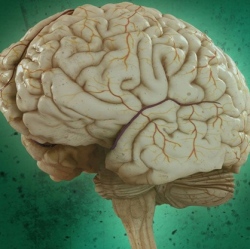
Researchers have developed a method to stimulate brain tissue using external magnetic fields and injected magnetic nanoparticles to treat neurological diseases such as Parkinson’s. Currently, brain stimulation uses pulses of electricity and requires a surgically implanted electrode wired to a power source outside the brain.
In their study, the team injected magnetic iron oxide particles 22 nanometers in diameter into the brain. When exposed to a low-frequency (100 kHz, 1 MHz) external alternating magnetic field, which can penetrate deep inside biological tissues, these particles rapidly heat up.
The resulting local temperature increase can then lead to neural activation by triggering heat-sensitive capsaicin receptors, the same proteins that the body uses to detect both actual heat and the “heat” of spicy foods. (Capsaicin is the chemical that gives hot peppers their searing taste.)
A team led by Polina Anikeeva, an assistant professor of materials science and engineering, used viral gene delivery to selected neurons in the brain to induce their sensitivity to heat.
The particles, which have virtually no interaction with biological tissues except when heated, tend to remain where they’re placed, allowing for long-term treatment without the need for further invasive procedures.
